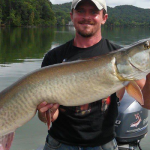By Nathan Shore
The most important factor in any walleye presentation isn’t the lure, technique, trolling speed or line size. All those things can be as important as the color of your boat. Like the way to a man’s heart, the way to walleyes is through their stomachs, and that means that your knowledge of the local baitfish can be the most important factor to catching lots of walleyes.

Jonny Petrowske is one man who knows baitfish better than you. He’s a Jack-of –all-trades, carving a life out of the Northwoods by running resorts, renting fish houses and plowing roads. He’s a fishing guide, too, and a darn good one, but he might say he wears his most important hat when gathering bait for clients and local shops. Baitfish habits, Petrowske claims, comprise the most important information a fisherman can own.
In Petrowske’s holistic angling world, everything is connected. A look at the lake, the season, the water temperature, and the conditions will suggest a crazy-quilt pattern of baitfish movements on any given day. Some minnows are moving inshore while some are moving out. Part of the walleye population will be close behind in every case. How much of the walleye population might be involved depends on abundance, so Petrowske keeps a finger on the pulse of baitfish populations in the waters he works.
Angling success in every season of the year, Petrowske says, is tied directly to the movements of baitfish. He considers the kaleidoscopic movements of spottail shiners, ciscoes, perch, chubs, dace, emerald shiners and whitefish, tries to picture the most prolific and concentrated scenario, and sets about tracking down those minnows to see what’s hunting them. Lure choice is anything but random. Petrowske matches the hatch with lures that imitate that particular baitfish in size, shape and color.
“Everybody gets so hung up on one run of baitfish,” Petrowske said. “Every walleye angler in the North knows about the ice-out spottail shiner run. Anglers beat that shallow shiner bite until July when spottails head to deeper water.”
Spottails are working their way out in early summer and for every 5-degree increase in water temperature they head 2-feet deeper, and while following them Petrowske is pulling size #5 Lindy Shadlings in Yellow Perch or Rainbow Smelt color patterns. Spottails have a green-brown back to them, and color selection is critical.
“Your bait should look like another sheep in the flock, but you want it to be a wounded sheep—the one with a limp,” he said. “Those big schools of spottails begin to dissipate out deep as water temperatures on top rise to 70-degrees and above, so why chase them all summer and into fall like the rest of the crowd? Let the migrations come to you.”
After all, there are plenty of fish in the sea. As surface temperatures cool toward the 60-degree mark in September, Petrowske changes his baitfish focus to emerald shiners, which come back out of open water.
“Some say it’s a feed thing, but when the emeralds run back into shore, I go to a size #5 Shadling in Tullibee or Alewife,” he said.

Identifying areas full of emeralds is easy by looking for minnows jumping out of the water. When the maple leaves start turning red and you have to put the sandals away, you can bet they’re shallow and walleyes aren’t far behind.
When water temperatures drop a little more and approach the 50-degree mark, giants come in to play.
“Now you’re seeing big, fat walleyes because tulibees, ciscoes, and whitefish are coming in to spawn. These are large baitfish, and you have to match the hatch to get the big girls to bite shallow.”
Emerald shiners are already in the shallows, and these bigger baitfish prefer rock and gravel in 10- to 15-feet of water. Petrowske trolls #7 Shadlings in Purple Smelt or Shiner to match the size and colors of these big-meal baitfish.
Ciscoes, tullibees and whitefish range over wider areas, but eventually coalesce into tight groups over very specific rock-gravel spots where spawning substrates are optimum. Casting and trolling defines the larger area, but when he finds heavy concentrations of bait, Petrowske pitches jigs.
“Hard breaks are where it’s at,” he said. “Sharp, rocky breaks down to 15-feet where rocks are too heavy to get a crank through is perfect for jigging.”
He prefers 1/4-ounce to ½-ounce Lindy Watsit jigs bulked up with the big 2-inch ‘Fat’ Watsit body, and subtle isn’t in his vocabulary. He twitches them sharply using a 7-foot, medium-power rod with 8-pound braided line tied directly to the jig. Sometimes he tips the jig with dead shiners toughened up with a salt brine.

“Rip-jigging tears off the bait off sometimes, but the big Watsit has tentacles that undulate, so if you lose your bait you’ve still got something to trigger strikes with,” he said. “It has a great, slow drop like a hair jig—a classic parachute effect. I rip the Watsit Spins, too, to add more vibration and flash to the jig in dark water.”
Tulibees and ciscoes reflect a lot of light in the blue-purple part of the spectrum, but also have darker accents. In clear water and on bright days, Petrowske imitates them with blue/white Watsit Jigs and bodies, but on dark days he prefers metallic gold.
“If you know when that first shallow movement begins in fall you’ll be in position and geared up in advance for the tulibee run and a parade of monster walleyes.”
Petrowske says walleye anglers make the mistake of chasing baitfish migrations instead of anticipating their movements and waiting for them to arrive.
“It’s like deer hunting. It’s easier to shoot one if you’re where it wants to be and it comes in calm, and a lot harder to hit one on the run.”






